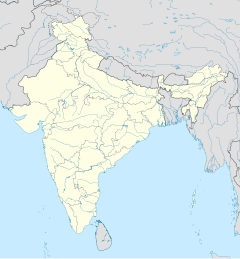เจนนเกศวเทวสถาน (โสมนาถปุระ)
เจนนเกศวเทวสถาน (กันนาดา: ಚೆನ್ನಕೇಶವ ದೇವಸ್ಥಾನ; Chennakesava Temple หรือ Chennakeshava Temple) หรือ เกศวเทวสถาน (กันนาดา: ಕೇಶವ ದೇವಸ್ಥಾನ; Keshava Temple) เป็นโบสถ์พราหมณ์ลัทธิไวษณวะ ตั้งอยู่ริมฝั่งแม่น้ำกาเวรี ในโสมนาถปุระ อำเภอไมสูรุ รัฐกรณาฏกะ ประเทศอินเดีย สร้างแล้วเสร็จในปี 1258 โดย โสมนาถ ทันทนายก (Somanatha Dandanayaka) นายพลในรัชสมัยของกษัตริย์นรสิงหที่สามแห่งจักรวรรดิโหยสฬะ เทวสถานนี้ตั้งอยู่ห่างไป 38 กิโลเมตร (24 ไมล์) ทางตะวันออกของนครไมสูรุ[2]
| เจนนเกศวเทวสถาน | |
|---|---|
 เจนนเกศวเทวสถาน โสมนาถปุระ | |
| ศาสนา | |
| ศาสนา | ศาสนาฮินดู |
| เทพ | พระเกศวะ (พระวิษณุ) |
| ที่ตั้ง | |
| ที่ตั้ง | โสมนาถปุระ รัฐกรณาฏกะ ประเทศอินเดีย |
| พิกัดภูมิศาสตร์ | 12°16′32.49″N 76°52′53.95″E / 12.2756917°N 76.8816528°E |
| สถาปัตยกรรม | |
| ประเภท | โหยสฬะ |
| ผู้สร้าง | โสมนาถ ทันทนายก |
| เสร็จสมบูรณ์ | 1258[1] |
เทวสถานนี้สร้างขึ้นด้วยสถาปัตยกรรมแบบโหยสฬะ เทวาลัยหลักตั้งอยู่ตรงกลาง ประกอบด้วยครรภคฤห์สามห้องที่สมมาตรกัน วางในทิศเหนือ-ใต้-ตะวันออก-ตะวันตก[3] ครรภคฤห์นี้ประกอบด้วยห้องตะวันตกซึ่งเคยเป็นที่ตั้งของเทวรูปพระเกศวะ (Kesava) ซึ่งสูญหายไปแล้ว ครรภคฤห์เหนือเป็นพระชนรรธนะ (Janardhana) และครรภคฤห์ทางใต้เป็นพระเวนุโคปาล (Venugopala) ทั้งสามองค์เป็นปาวอวตารของพระวิษณุ[4] ทั้งสามห้องครรภคฤห์มีโถงกลางร่วมกันคือ สภามณฑป (sabha-mandapa) ซึ่งมีหลายเสา ผนังด้านนอก ผนังด้านใน เสา และเพดาน ของทั้งเทวสถานล้วนแกะสลักอย่างวิจิตรด้วยภาพทางเทววิทยาของศาสนาฮินดู รวมถึงยังมีงานแกะสลักภาพจากคัมภีร์ของฮินดู เช่น รามายณะ ทางใต้, มหาภารตะ ทางเหนือ และ ภาควตปุราณะ ทางตะวันตก[1]
จอร์จ มีเชล (George Michell) ระบุว่าเจนนเกศวรเทวสถานแห่งโสมนาถปุระถือเป็นจุดสูงสุดของการพัฒนาสถาปัตยกรรมโบสถ์พราหมณ์แบบโหยสฬะ และมีความโดดเด่นพิเศษในหลายแง่มุม[5]
อ้างอิง
แก้- ↑ 1.0 1.1 Kirsti Evans (1997). Epic Narratives in the Hoysaḷa Temples: The Rāmāyaṇa, Mahābhārata, and Bhāgavata Purāṇa in Haḷebīd, Belūr, and Amṛtapura. BRILL Academic. pp. 10–11. ISBN 90-04-10575-1.
- ↑ Keshava Temple, Somnathpura, Karnataka เก็บถาวร 23 ตุลาคม 2017 ที่ เวย์แบ็กแมชชีน, Government of Karnataka, India
- ↑ Margaret Prosser Allen (1991). Ornament in Indian Architecture. University of Delaware Press. p. 217. ISBN 978-0-87413-399-8.
- ↑ Fredrick W. Bunce (2002). The Iconography of Architectural Plans: A Study of the Influence of Buddhism and Hinduism on Plans of South and Southeast Asia. DK. pp. 118–120. ISBN 978-81-246-0200-3.
- ↑ George Michell (1977). The Hindu Temple: An Introduction to Its Meaning and Forms. University of Chicago Press. pp. 146–148. ISBN 978-0-226-53230-1.
บรรณานุกรม
แก้- Prasanna Kumar Acharya (2010). An encyclopaedia of Hindu architecture. Oxford University Press (Republished by Motilal Banarsidass). ISBN 978-81-7536-534-6.
- Prasanna Kumar Acharya (1997). A Dictionary of Hindu Architecture: Treating of Sanskrit Architectural Terms with Illustrative Quotations. Oxford University Press (Reprinted in 1997 by Motilal Banarsidass). ISBN 978-81-7536-113-3.
- Vinayak Bharne; Krupali Krusche (2014). Rediscovering the Hindu Temple: The Sacred Architecture and Urbanism of India. Cambridge Scholars Publishing. ISBN 978-1-4438-6734-4.
- Alice Boner (1990). Principles of Composition in Hindu Sculpture: Cave Temple Period. Motilal Banarsidass. ISBN 978-81-208-0705-1.
- Alice Boner; Sadāśiva Rath Śarmā (2005). Silpa Prakasa. Brill Academic (Reprinted by Motilal Banarsidass). ISBN 978-8120820524.
- A.K. Coomaraswamy; Michael W. Meister (1995). Essays in Architectural Theory. Indira Gandhi National Centre for the Arts. ISBN 978-0-19-563805-9.
- Dehejia, V. (1997). Indian Art. Phaidon: London. ISBN 0-7148-3496-3.
- Adam Hardy (1995). Indian Temple Architecture: Form and Transformation. Abhinav Publications. ISBN 978-81-7017-312-0.
- Adam Hardy (2007). The Temple Architecture of India. Wiley. ISBN 978-0470028278.
- Adam Hardy (2015). Theory and Practice of Temple Architecture in Medieval India: Bhoja's Samarāṅgaṇasūtradhāra and the Bhojpur Line Drawings. Indira Gandhi National Centre for the Arts. ISBN 978-93-81406-41-0.
- Harle, J.C., The Art and Architecture of the Indian Subcontinent, 2nd edn. 1994, Yale University Press Pelican History of Art, ISBN 0300062176
- Monica Juneja (2001). Architecture in Medieval India: Forms, Contexts, Histories. Orient Blackswan. ISBN 978-8178242286.
- Stella Kramrisch (1976). The Hindu Temple Volume 1. Motilal Banarsidass (Reprinted 1946 Princeton University Press). ISBN 978-81-208-0223-0.
- Stella Kramrisch (1979). The Hindu Temple Volume 2. Motilal Banarsidass (Reprinted 1946 Princeton University Press). ISBN 978-81-208-0224-7.
- Michael W. Meister; Madhusudan Dhaky (1986). Encyclopaedia of Indian temple architecture. American Institute of Indian Studies. ISBN 978-0-8122-7992-4.
- George Michell (1988). The Hindu Temple: An Introduction to Its Meaning and Forms. University of Chicago Press. ISBN 978-0-226-53230-1.
- George Michell (2000). Hindu Art and Architecture. Thames & Hudson. ISBN 978-0-500-20337-8.
- M.H. Krishna (1965). Annual report of the Mysore Archeological Department. University of Mysore.
- Kamath, Suryanath:A Concise History of Karnataka from pre-historic times to the present, 2001, Jupiter books, MCC, Bangalore (Reprinted 2002) OCLC: 7796041.
- Foekema, Gerard:A Complete Guide to Hoysala Temples, Abhinav, 1996 ISBN 81-7017-345-0
- Sastri, Nilakanta K.A.:A History of South India, 1955, From Prehistoric times to fall of Vijayanagar, Oxford University Press, New Delhi (Reprinted 2002), ISBN 0-19-560686-8.
- "U.B. Githa, Hoyasala architecture in Somanathapura". คลังข้อมูลเก่าเก็บจากแหล่งเดิมเมื่อ 2006-06-14. สืบค้นเมื่อ 2006-11-13.
- "Architecture of the Indian subcontinent, Takeyo Kamiya". สืบค้นเมื่อ 2006-11-13.
- T. A. Gopinatha Rao (1993). Elements of Hindu iconography. Motilal Banarsidass. ISBN 978-81-208-0878-2.
- Ajay J. Sinha (2000). Imagining Architects: Creativity in the Religious Monuments of India. University of Delaware Press. ISBN 978-0-87413-684-5.
- Burton Stein (1978). South Indian Temples. Vikas. ISBN 978-0706904499.
- Burton Stein (1989). The New Cambridge History of India: Vijayanagara. Cambridge University Press. ISBN 978-0-521-26693-2.
- Burton Stein; David Arnold (2010). A History of India. John Wiley & Sons. ISBN 978-1-4443-2351-1.
- Kapila Vatsyayan (1997). The Square and the Circle of the Indian Arts. Abhinav Publications. ISBN 978-81-7017-362-5.

